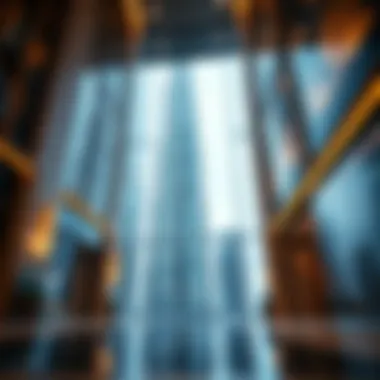Exploring the Second Tallest Building in the World


Intro
The skyline of Dubai is a remarkable canvas, showcasing a mix of traditional Islamic art and futuristic architecture. Among its towering structures, the second tallest building in the world stands as a symbol of innovation and ambition. This article offers a close look at this architectural marvel, unraveling its significance—both culturally and economically.
From the audacious ideas that conceived its design to the rigorous engineering challenges faced during its construction, this structure does not merely scrape the sky but also touches the very heart of urban progress. More than just an aesthetic wonder, it plays a pivotal role in shaping the dynamics of Dubai’s real estate market and the broader landscape of global architecture.
As we embark on this exploration, we will delve into current trends within the Dubai real estate scene and scrutinize the economic variables influencing property values in this bustling city. Insights will be drawn to benefit not just potential investors and buyers but also real estate professionals navigating this competitive terrain.
Beyond numbers and statistics, the human element of this building’s story will be highlighted. In doing so, we aim to convey its cultural meaning to the local populace and its role in attracting both tourist dollars and international investors. Join us as we journey through the intricate layers of significance encapsulated by this monumental structure.
Prolusion to Architectural Heights
In the realm of architecture, height has always been a captivating subject that stirs not just competitiveness among builders but also fascination among onlookers. When we engage with the concept of architectural heights, it transcends mere numbers. It's about societal aspirations, engineering marvels, and cultural identity. This article sets out to explore the implications of these towering structures, particularly focusing on the second tallest building in the world.
Understanding architectural heights helps illuminate their importance in modern society. Such monumental achievements encapsulate not just the technical prowess of engineering but also signify a city’s global standing and cultural ethos. As we delve into the nitty-gritty of impressive skyscrapers, we’ll uncover how they influence urban landscapes, shape real estate markets, and redefine skyline definitions.
The rapid advancement in building technology—coupled with innovative design philosophies—has enabled architects to push boundaries and rethink the possible. As certain cities continue to dominate the skyline, the measurements of height evolve to reflect not only the aspirations of communities but also their underlying economic and social fabric.
Defining 'Tallest' in Architecture
To many, the term 'tallest' appears straightforward, but it encompasses various intricacies. Is it merely the metric measurement from ground level to roof? Or does it consider architectural features like spires? In practice, several factors come into play when determining height.
The criteria can differ based on organizations, local regulations, and even technological advancements. For instance, the Council on Tall Buildings and Urban Habitat (CTBUH) has established specific guidelines for height categorization, including:
- Overall building height: the distance from the ground level to the highest point of the building, excluding antennae.
- Height to architectural top: from the ground to the uppermost architectural feature.
- Height to the highest occupied floor: significant for evaluating usable space.
These distinctions can stir debates and even disagreements among experts. Certain buildings may claim supremacy in different categories, leading to competitive narratives and further studies in architectural design.
Historical Overview of Skyscrapers
The journey of skyscrapers is a vivid tapestry weaving together epochs of technological innovation and cultural shifts. The late 19th century heralded the age of the skyscraper, a direct response to urban population booms. Chicago's Home Insurance Building, completed in 1885, is frequently regarded as the first true skyscraper, paving the way for towering giants.
As the 20th century rolled in, advancements in steel frame construction allowed for ever-increasing heights. The Empire State Building opened in 1931 as the tallest structure of its time, making a bold statement about American ingenuity and ambition. This era marked not just architectural growth but also a shift in socioeconomic dynamics—skyscrapers became symbols of economic power and aspiration across major cities.
In more recent years, the desire for vertical expansion took root in countries like the United Arab Emirates and China, where the skyline is ever-evolving. Buildings like the Burj Khalifa and Shanghai Tower now dominate discussions around architectural achievements. They reflect national pride and a willingness to invest in infrastructure that marks both cultural and economic identities on the world map.
Understanding this history provides context to the ongoing developments and choices made in contemporary architecture. By looking at architectural heights through a historical lens, we can appreciate the avenues that shaped them into the spectacular edifices they are today.
The Current Titleholder of the Second Tallest Building
The significance of the current titleholder of the second tallest building cannot be overstated. This majestic structure not only changes the skyline but challenges the boundaries of architecture and engineering. As a centerpiece in its urban environment, it represents cultural milestones and economic advancements that cities aspire to achieve. The reactions and admiration it garners from locals and visitors alike attest to its importance.
Building Specifications
Height and Floor Count
The height of a skyscraper is often the first thing that comes to mind when discussing such structures. The second tallest building stands at an impressive height of 828 meters (2,717 feet), with a whopping 163 floors. This remarkable height plays a crucial role in defining the city's character. Tall structures like this one are often seen as symbols of technological progress and urban sophistication.
For investors and developers, understanding the height and floor count of skyscrapers can be pivotal. A taller building typically offers more rental units, generating higher returns. Additionally, this specific height is a strategic marketing edge, especially in a real estate market as competitive as Dubai’s. On the flip side, the very attributes that make such heights appealing—certain construction complexities and operational costs—may also present drawbacks.
Design Features
Design features of the building are equally fascinating and functional. The sleek, tapering form reduces wind pressure and integrates advanced aerodynamics, a critical consideration given the region’s strong desert winds. The glass façade provides breathtaking views and enhances energy efficiency through natural lighting, reducing reliance on artificial sources.
This striking visual identity also attracts attention, making it a landmark that puts both locals and tourists in awe. Sustainable aspects in the design, like integrated solar panels and water conservation systems, make it a favorable highlight for eco-conscious investors while still delivering aesthetics and functionality.
Materials Used
Materials utilized in the building's construction underscore its enduring strength and modernity. High-performance steel and reinforced concrete are predominant, lending the structure durability against harsh weather conditions and ensuring longevity. The choice of these materials is largely beneficial; they facilitate swift construction and maintain low maintenance needs.
An interesting feature is the use of local materials where possible, emphasizing a commitment to the region while also reducing transport costs. However, sourcing and costs of specific materials can fluctuate, presenting both opportunities and risks depending on market conditions.
Architectural Design and Vision
Architect Profile


The architect behind this vertical titan is a name synonymous with the world's most prestigious skyscrapers. This figure has a portfolio showcasing creative ingenuity and an impressive mastery of design principles. They adopt a philosophy that marries aesthetics with function, which is essential for high-rise buildings in bustling urban areas.
Their unique ability to balance bold architectural visions with practical realities is why their designs endure through decades, making them a go-to for ambitious projects. However, such visionary approaches can sometimes lead to debates regarding feasibility and budget constraints, which stakeholders must navigate carefully.
Design Challenges
While the end result is visually striking, the road to completing such an ambitious project is fraught with unique challenges. One significant hurdle includes adhering to stringent safety standards, both for structural integrity and sustainability compliance. It requires meticulous planning, a comprehensive approach to risk management, and innovative solutions, such as advanced modeling technologies.
These design challenges can create delays and increased costs, but overcoming them also often results in groundbreaking innovations that push architectural parameters further.
Innovative Techniques
The innovative techniques used in the construction of the building are among its most noteworthy aspects. Techniques like modular construction and the utilization of digital twin technologies enabled the construction team to simulate various aspects of the structure before actual work commenced. This cuts down unforeseen issues and promotes efficiency.
Investors might find such methods appealing because they help flatten the learning curves in future developments. Encouraging adoption of these techniques can also mark a positive step towards reducing environmental impact during both construction and operation. However, the initial investment in technology can be a point of contention.
"In architecture, every height tells a story, and every floor represents potential."
Construction Timeline and Progress
The construction timeline offers insight into the intricate dance of planning, execution, and unforeseen challenges that shape a skyscraper's rise into the skyline. This journey includes various phases, starting from the inception of the project and moving through groundbreaking to completion. By understanding the construction process, stakeholders can appreciate not only timelines but also underlying factors that impact the building’s future.
Project Initiation
Feasibility Studies
Conducting feasibility studies is a quintessential part of any ambitious construction project. These studies assess the viability of the building in various aspects, including financial, environmental, and regulatory. One notable characteristic of feasibility studies is their comprehensive nature, which allows stakeholders to make informed decisions early on.
The study lays out crucial elements such as site selection, zoning laws, and potential market demand, ultimately guiding whether the project is worth pursuing. This is particularly beneficial because securing necessary funding heavily relies on a clear understanding of potential risks and returns.
A unique feature of feasibility studies is their capacity to adapt, driven by evolving market conditions or technological changes. However, a drawback may lie in their complexity; lengthy studies can delay project initiation, possibly leading to missed market opportunities. In the context of constructing the second tallest building, these studies ensure that every angle is considered before digging into the earth.
Funding and Investment
Funding and investment represent a substantial pillar in the skyscraper's construction narrative. At this stage, attracting intelligent investors is crucial as it can pave the way for financial stability throughout the project's lifecycle. The cornerstone of this effort typically revolves around solid investment pitches grounded in previous feasibility assessments. This characteristic makes funding crucial and provides a strong backbone for construction timelines.
Moreover, innovation in funding methods—like green bonds or public-private partnerships—has modified traditional investment channels. Still, potential risks exist, particularly related to market fluctuations that might sway investors’ confidence. Without a firm financial commitment, ambitious designs can quickly wobble, posing serious threats to timelines and overall project viability.
Construction Phases
Groundbreaking Ceremony
The groundbreaking ceremony marks the official start of construction and plays a symbolic role in unifying stakeholders, from investors to future tenants. This event often draws attention, serving a dual purpose: announcing the project to the public and generating excitement. The ceremony, characteristic for its fanfare and media coverage, lays the groundwork for community involvement.
However, beyond the surface flair, this event carries practical significance; it secures buy-in from local authorities and can even help mitigate potential future disputes. Introducing community stakeholders ensures they have a stake and voice, which contributes beneficially to local support. On the flip side, if poorly executed, the ceremony can lead to unrealistic expectations that may burden the project later.
Key Milestones
Key milestones throughout the construction phases function as markers of progress, allowing investors and management teams to gauge how well the project aligns with its timelines. One of the core features of these milestones is their ability to highlight both completed phases and upcoming challenges, creating momentum for teams working on the ground.
Furthermore, they can aid in communicating progress to potential buyers and stakeholders, reinforcing confidence in the project. Each milestone serves as a tangible sign of advancement, such as reaching foundation depth or topping out the structure. Yet, these milestones hinge heavily on efficient project management; lapses can lead to delays that may ripple through the timeline.
Completion Date
The completion date represents the culmination of this complex saga of construction, marking the transition from construction to occupancy. It is not merely an end point but symbolizes the fulfillment of a collective vision. A critical aspect of the completion date lies in ensuring it aligns with marketing campaigns and investor timelines, making it essential for the project's economic return.
Characteristics of completion dates include their role as performance indicators, reflecting how well the construction adhered to initial projections. This date is critical for real estate strategies, impacting leasing rates and sales opportunities. However, delays can hit hard, risking the entire financial structure laid down at the project’s inception. Navigating setbacks is ever-present in this line of work, emphasizing the need for thorough planning and adaptability.
"Understanding the complete arc of construction timelines sheds light on the architecture of economic and cultural impacts that these towering structures create."
By piecing together these elements, we create a richer understanding of the dynamics at play, allowing stakeholders to engage with the project not just as bystanders, but rather as proactive participants in a greater urban narrative.
Cultural and Urban Impact
The second tallest building in the world not only reaches for the sky but also plays an important role in shaping the cultural and urban landscape of its surroundings. Its towering presence serves as a catalyst for a multitude of societal interactions while influencing urban aesthetics and identity. In this section, we will explore the significant elements that illustrate how this structure transcends its physical architecture, contributing to the cultural fabric and urban dynamics of the city.


Symbolism in Architecture
Architecture has an inherent way of symbolizing the aspirations and identity of a society. The second tallest building stands as a monumental representation of human ingenuity and ambition. To many, it is more than just steel and glass; it embodies a relentless pursuit of dreams, progress, and modernity. Such structures become landmarks, helping to craft a city's image on the global stage.
"Tall buildings are a statement, a narrative of what a location stands for. They elevate not just the skyline but the spirit of a community."
Consider the symbolism it denotes—strength, resilience, and innovation. In cultures where height signifies prestige, this skyscraper embodies those values. As it scrapes against the clouds, it tells locals and visitors alike that their city is a player in global conversations about economics and culture. It thus nurtures a sense of pride while attracting international attention, ultimately enriching the city's branding and identity.
Influence on Local Tourism
The impact of the skyscraper also extends into the arena of local tourism, serving as a magnet that draws millions of visitors every year. This significant attraction raises the profile of the city as a major travel destination, opening the doors to several economic advantages.
Visitor Statistics
Visitor statistics point to a booming influx of tourists intrigued by the majesty of the building. A notable aspect of these statistics reveals that millions visit each year, a number that continuously grows, further fueled by social media showcasing its artistic and architectural uniqueness. As per recent surveys, a significant percentage of visitors cite the tower as a primary reason for their trip, thus making it a beneficial choice for marketing campaigns aimed at tourism.
The unique feature of these statistics is how they also reflect seasonal trends, revealing peaks during holidays and international events. Such trends enable planners and local businesses to harness opportunities, crafting tailored experiences to better accommodate fluctuating tourist demands.
Tourism Infrastructure
Moreover, the tourism infrastructure surrounding the second tallest building has progressed to meet the needs of an ever-growing visitor base. This infrastructure embodies restaurants, hotels, shopping centers, and transportation hubs, which have expanded simultaneously with the building's presence.
A key characteristic of this infrastructure is its accessibility. With improved transport links, visitors can easily navigate the city, enhancing their overall experience. However, it presents challenges, such as overcrowding—an undeniable downside as traffic and congestion in the area can be overwhelming during peak seasons. Balancing growth with sustainability is thus a pressing matter for local authorities as they seek to maintain a high-quality visitor experience while preserving the existing residential and commercial ecosystems.
Economic Considerations
Economic considerations play a pivotal role in understanding the second tallest building in the world. They go beyond mere figures of height and design. Instead, they encompass how such monumental structures influence local and global economies, enhancing property value, tourism, and investment opportunities. The overshadowing benefits of erecting a skyscraper of this enormity cannot be understated; they reshape urban landscapes and breathe new life into surrounding areas. Investors, agents, and developers alike have a keen eye on these facets, eager to uncover what treasure lies beneath the surface of towering concrete and steel.
Real Estate Value Trends
Market Growth Post-Completion
Post-completion of the second tallest building, there’s often a noticeable uptick in market growth. The sheer scale of the building draws attention not only within the architectural community but also among investors looking to capitalize on emerging opportunities. The key characteristic here is the building’s ability to act as a catalyst for newfound interest in the local real estate market. This results in increased property values and robust demand for office and residential spaces in proximity to the skyscraper.
Furthermore, its unique feature lies in its iconic status, which often raises demand even before completion due to anticipation. Potential buyers recognize the benefits of owning property near such a landmark, as it generally guarantees higher footfall and visibility. However, rapid growth can come with challenges, such as ensuring infrastructure can keep pace with the developments, potentially leading to elevated prices that may temporarily shutter accessibility for some buyers.
Comparative Analysis with Other Global Markets
Analyzing the second tallest building’s economic impact reveals disparities when compared with other global real estate markets. The key characteristic of this comparative analysis reveals that while many global cities have undergone transformations due to skyscrapers, the context matters immensely. A major city like Dubai, where this building resides, thrives due to a flurry of cultural and economic events that amplify investment opportunities.
The unique feature of this analysis is its emphasis on the economic ripples caused by the building’s presence. Global markets fluctuate, often influenced by local developments and international trends. As a result, some global markets may experience slower advances. In contrasts, the real estate vibration caused by the second tallest building can predict a surge in related investments in Dubai. While beneficial, it’s noteworthy that these conditions must be approached with caution, as over-saturation can trigger price corrections and uncertainties in the long haul.
Investment Opportunities
Commercial Space Rentals
With the rise of the second tallest building, commercial space rentals have become increasingly appealing. The key characteristic here is the visibility and prestige that such a prime location offers to businesses wanting to make their mark in the marketplace. Areas surrounding the building typically become hotspots for retail franchises, tech startups, and global firms each vying for a slice of high-traffic locatioons.
The unique feature of commercial rentals in such high profile areas is their tendency for a higher-than-average return on investment. However, it is crucial for potential lessees to assess market conditions regularly, as fluctuations in demand might affect rental prices, making it vital for businesses to maintain flexibility in their leasing strategies or risks becoming overpriced.
Residential Market Dynamics
Residential dynamics surrounding this towering structure tend to shift dramatically post-construction. The key characteristic of this segment is the affluent buyer persona it attracts. High-income individuals or expatriates often seek residence close to such architectural marvels, ensuring a strong demand in luxury housing markets.
The unique feature of residential properties near the second tallest building is the potential for price appreciation over time, often leaving early buyers relishing in significant returns. However, it’s important to note that this sector may also face challenges, such as an oversupply of luxury units if developers misjudge market demand. The push-pull nature of residential dynamics is an important consideration for any investor or developer eyeing this lucrative but volatile market.
By closely examining these economic considerations, we can glean valuable insights into the symbiotic relationship between monumental architecture and thriving economies. Understanding the intricacies of value trends, investment opportunities, and the impact on the local landscape will better equip all stakeholders for the challenges and rewards that lie ahead.
For more on real estate dynamics, check out resources from Wikipedia and Britannica.
Sustainable Architecture Practices
The pressing need to integrate sustainability into modern architecture cannot be overstated. As the world grapples with climate change and dwindling resources, buildings must evolve beyond mere structures; they need to embody practices that respect both people and the planet. The second tallest building stands as a beacon of these sustainable architecture practices, showcasing how design can intersect with ecological responsibility. Investing in sustainable architecture not only elevates aesthetic appeal but also enhances long-term value, making it a smart choice for developers, investors, and residents alike.
Eco-Friendly Design Features


In the construction of colossal buildings like this one, eco-friendly design features play a crucial role. These elements often begin with the utilization of materials that are either recycled, sustainable, or sourced locally. For instance, using bamboo or reclaimed wood can significantly reduce the carbon footprint associated with material transportation. Moreover, incorporating green roofs and vertical gardens not only provides insulation but also fosters biodiversity in urban areas. These design motifs not only are environmentally sound but also offer residents a rare slice of nature amidst concrete jungles.
Additionally, intelligent placement of windows—often referred to as 'daylighting'—maximizes natural light, reducing dependency on artificial lighting. This intuitive design strategy can lead to energy savings, creating a comfortable atmosphere within workspaces and residential units alike.
Energy Efficiency Measures
Energy efficiency is not merely about cutting costs; it's about forging a sustainable future. Several measures can be integrated into skyscrapers to ensure they consume less energy and lower greenhouse gas emissions.
Renewable Energy Sources
When discussing renewable energy sources in the context of this towering structure, solar panels emerge as a notable highlight. These panels harness sunlight, converting it into usable energy, which can significantly diminish reliance on fossil fuels. The key characteristic of solar panels lies in their ability to generate power without emitting harmful pollutants, making them an invaluable component of sustainable architecture. For this article, promoting solar power is beneficial as it not only supports the building’s operational needs but also reduces the overall environmental impact.
A unique feature of integrating solar energy into building designs is the potential for energy independence. When properly installed and optimized, solar systems can provide enough energy to cover significant portions of a building's energy demands, leading to savings on utility bills and improving the building's market standing among environmentally-conscious buyers.
Water Conservation Techniques
Water scarcity poses a threat across the globe, and implementing effective water conservation techniques within skyscrapers can make a substantial difference. These techniques often include rainwater harvesting systems, which collect rain that can be reused in irrigation or plumbing needs, representing a critical aspect of sustainable building practices.
This emphasis on water conservation highlights a key feature: the dual benefit of reducing waste and lowering costs. For investors and developers, investing in water-efficient technologies makes economic sense while also contributing to a more sustainable urban ecosystem. However, these systems can require high initial investment for installation, making thorough planning essential to ensure long-term benefits outweigh upfront expenses.
Implementing these sustainable practices not only aligns with a broader commitment to environmental stewardship but also resonates with a growing demographic of eco-conscious residents and investors. As the world leans into a future where climate-friendly initiatives are non-negotiable, integrating such aspects in architectural projects will place stakeholders one step ahead in the competitive landscape.
Future Prospects in Skyscraper Development
The ever-evolving skyline of modern cities often sparks curiosity about what lies ahead in architectural innovation. Future prospects in skyscraper development have become a hot topic, especially given recent advancements in technology, sustainability, and urban design. Understanding these prospects not only provides insights into the next generation of high-rise structures but also sheds light on the broader implications for urban life, economic growth, and environmental stewardship.
Emerging Architectural Trends
As cities expand and populations grow, new architectural trends are emerging to address the challenges that accompany rapid urbanization. One notable trend is the integration of smart technologies into building design. For instance, skyscrapers are now being equipped with advanced sensors and automation systems to enhance energy efficiency and improve tenant comfort. This marriage of technology and architecture leads to structures that can adapt to changing conditions and resident needs.
Another significant trend is the focus on biophilic design, which emphasizes the inclusion of natural elements within urban landscapes. Skyscrapers featuring vertical gardens and green roofs are increasingly popular, as they not only enhance aesthetic beauty but also contribute to improved air quality and biodiversity. With the wake of climate change, these innovations are becoming essential for cities aiming to maintain livability.
The Quest for the Next Tallest Structure
Competitors
The race to build the next tallest skyscraper is fierce, with several ambitious projects already underway around the globe. One prominent competitor in this field is the Jeddah Tower in Saudi Arabia, aiming to soar to a staggering height of 1,000 meters. This structure is designed not just to break records, but also to serve as a catalyst for urban development in its surrounding area. What makes Jeddah Tower particularly noteworthy is its mixed-use approach, promising spaces for living, working, and leisure all within a single iconic structure.
The key characteristic of such competitors is their capacity to redefine urban landscapes. Beyond mere height, they aim to incorporate state-of-the-art sustainability features. However, these grand designs also encounter challenges, including the logistical hurdles of construction and the political landscape of the region. In the end, each competitor contributes uniquely to the dialog about the future of skyscrapers.
Predictions for the Future
Looking ahead, predictions for the future of skyscraper architecture reveal an increasing shift towards sustainability and resilience. Industry experts often emphasize that future projects must prioritize environmental considerations, potentially leading to a rise in the development of structures made from renewable materials and those that utilize zero-energy designs.
Another aspect of future predictions involves the potential for community-driven designs. As urban dwellers become more involved in planning processes, architects may find themselves increasingly adapting their designs to meet public needs and preferences. This might also include integrating more public spaces within skyscrapers, fostering a communal atmosphere despite the towering heights.
In summary, the importance of understanding future prospects in skyscraper development cannot be overstated. Innovators push the envelope, balancing height with sustainability, technology, and community engagement. Ultimately, as we look out into an undeniably vertical future, the intrigue surrounding these towering structures will continue to shape the urban environment and economic landscapes for years to come.
The End: The Significance of Height
The discussion surrounding towering structures isn’t just about their physical dimensions; it delves significantly into the implications they carry for urban spaces. As we round up our exploration of the second tallest building in the world, it’s essential to appreciate how height plays a vital role in urban identity, economic prosperity, and architectural innovation. In the fabric of a city, a skyscraper does more than scrape the sky; it becomes a symbol of ambition, advancement, and a beacon for countless stakeholders.
Reflecting on Urban Identity
In cities around the globe, skyscrapers often represent more than just architectural feats; they are a reflection of the aspirations of a community. The second tallest building is a prime example of this phenomenon. Its sleek design and towering presence can ignite pride among residents and set the tone for what defines the city’s skyline.
Not only do such structures contribute to the aesthetics of a metropolis, but they also shape the cultural narrative. For instance, buildings like this one could symbolize resilience, creativity, and progression in a rapidly changing world.
- Symbolic Significance: The visual impact of the building can instill a sense of belonging and connection among locals. Such iconic structures often become focal points for gatherings and celebrations.
- Architectural Legacy: The architectural style and planning also help to reinforce a locality's historical context. What message about the future and past does this skyscraper send?
The presence of such grandiosity also invites comparisons with the historic structures that flank the city, underscoring the balance between tradition and modernity. For entrepreneurs and investors, this may translate to higher demand for commercial spaces and a revitalized interest in the surrounding areas.
Final Thoughts on Skyscapes
In sum, skyscrapers often encapsulate the dreams and goals of their time. The second tallest building in the world is not merely a tall structure; it stands as a testament to human ingenuity and the relentless drive to push boundaries in architecture and engineering. It adds to the discourse on sustainability, designing spaces in harmony with the environment while meeting the demands of modern urban life.
Ultimately, the significance of height lies in its ability to inspire, challenge, and transform how we think about cities. As investors, architects, and urban planners look toward the future, the study of how such structures fit into the broader context of urban development will be vital. The evolution of our cityscapes relies on these towering giants not just for their physical space, but for the very ethos they embody.
"Architecture should speak of its time and place, but yearn for timelessness." – Frank Gehry
Thus, as we ponder on future development prospects in skyscraper construction, it is essential to keep a discerning eye on how these architectural marvels can balance functionality with the cultural tapestry they enrich. The interplay of height and identity solidifies the notion that the tallest buildings are not just structures; they resonate with the soul of the city.







